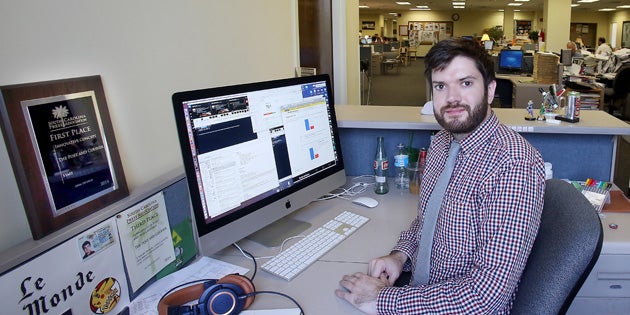Emory Parker ‘10 started college with plans to become a medical doctor.
Less than a decade later, he found himself part of a team of journalists who won a Pulitzer Prize. Not bad for a biology major turned multimedia editor.
As the interactive editor for The (Charleston) Post and Courier, Parker helps traditional journalists tell their stories in exciting new ways. For the newspaper’s Pulitzer Prize-winning series on domestic violence, “Till death do us part,” Parker created digital maps, timelines and more to illustrate the severity of South Carolina’s criminal domestic violence problem. The Palmetto State has ranked among the top 10 states for criminal domestic violence for the past 15 years.
Because South Carolina has had such a longstanding problem with domestic violence, it proved difficult for journalists to report the issue in novel and meaningful ways. Among the questions Parker and his reporter colleagues at the newspaper asked themselves when tackling this project:
How do we break that cycle?
How do we go beyond saying the same thing over and over?
Their solution was to create a package of long-form reporting, video interviews with abuse victims, and interactive web features that made plain the depth of the state’s domestic violence problem.

The Charleston Post and Courier’s investigative series on domestic violence, “Till death do us part.”
As Post and Courier reporter Doug Pardue says of Parker, “he very effectively divided a fairly standard newspaper series with sidebars into a fluid seven-part web presentation.”
“He also helped make us iron-clad,” continues Pardue, “by liberally placing links in the story to show readers the origin of each one of our assertions and facts.“
Such storytelling, Parker agrees, was critical for drawing attention to some of the reasons behind the high domestic violence rate and a perception that lawmakers were not adequately addressing the issue.
“That’s what really got to me, the inequity of the laws and the intransigence of the legislature,” says Parker.
Mentioning one example of the broken support system for domestic violence victims in South Carolina, Parker says “we have more shelters for dogs than battered women.”
Telling good stories in even better fashion has long been a goal of Parker’s. He joined the College’s student media group when he was a freshman and soon played a hand in reshaping the organization for the digital age. At the time, student media included a separate newspaper, radio station and television station. The group was also paying a large portion of their budget for old-school or “legacy” programming and content that was being enjoyed by a small audience. The solution crafted by Parker and others: consolidate and modernize. The result was CisternYard Media, which encompasses the George Street Observer, CofC Radio and Cougar Television.
“We figured if we could roll everyone under the same umbrella, the same brand, we could reach out to the campus community better,” says Parker.
RELATED: Read how alum Geoff Yost ’12 helped reinvent student media at the College.
More recently, Parker has helped report on the killing of nine people at Emanuel AME Church in Charleston and ensuing calls to remove the Confederate Flag from the grounds of South Carolina’s state capitol. Parker and his colleagues at The Post and Courier created graphics that showed the position each state legislator in South Carolina has taken regarding the Confederate Flag, earning kudos from national media outlets like The Huffington Post.
Parker thinks such innovative approaches to storytelling pay great dividends for readers.
“When you combine the data with the anecdotes and personal stories, that creates a much more powerful story overall.”
And while he says it’s both “the highest honor” and “incredibly humbling” to be part of a team awarded the Pulitzer Prize, Parker is more excited that the newspaper has drawn attention to the problem of domestic violence in South Carolina and has even prompted some changes in state law to address the issue.
“Hopefully at the end of the day lives will be saved,” says Parker. “That’s what really matters.”





